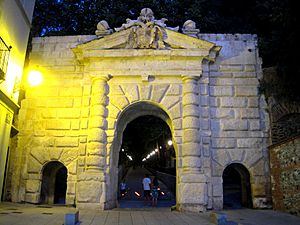Gate of the Pomegranates facts for kids
Quick facts for kids Gate of the Pomegranates |
|
|---|---|
| Native name Spanish: Puerta de las Granadas |
|
 |
|
| Location | Granada, Spain |
| Official name: Puerta de las "Granadas" | |
| Type | Non-movable |
| Criteria | Monument |
| Designated | 1870 |
| Reference no. | RI-51-0000009 |
| Lua error in Module:Location_map at line 420: attempt to index field 'wikibase' (a nil value). | |
The Gate of the Pomegranates (in Spanish, Puerta de las Granadas) is an old, important entrance in Granada, Spain. It's like a grand doorway that leads to the famous Alhambra palace. This path starts in the city center at Plaza Nueva. It then goes up a street called Cuesta de Gomérez until you reach the gate.
Contents
What the Gate Looks Like
This gate was built to look like the grand Roman arches that celebrated victories. It has a classic front design. This makes it the main entrance to the walled area around the Alhambra.
It was built during the Spanish Renaissance, a time when art and architecture were very important. Emperor Charles V ordered its construction. The gate is made from strong, carved stone. It has smooth, detailed designs, showing off the skill of the builders.
A Quick Look at History
Building the Gate of the Pomegranates started in 1526. It was made to celebrate a special visit by Charles I of Spain to Granada. He came after his wedding to Isabel of Portugal. The idea for the gate came from Luis Hurtado. The work was done by Íñigo López. He got help from Pedro Machuca, who also designed the Palace of Charles V.
The new gate replaced an older Islamic gate. That old gate was called Bib al-Buxar, or Bib al-Jaudaq. It was a defensive tower that protected the valley nearby. You can still see some parts of the old Arabic design on the right side of the gate. On the left side, there is a fancy door that leads to the Palace of the Marquise of Cartagena.
Why It's Called the Gate of the Pomegranates
This gate used to be known as the Door of the Gomérez. It got its new name from three large, open pomegranates on top of the main arch. Pomegranates are a fruit.
Above the pomegranates, you can see the royal shield of Charles I of Spain and V of Germany. There are also figures representing Peace and Abundance. These were ideas that Charles I's government promised to bring to the new lands of Al-Andalus.
Paths Through the Gate
Behind all the arches of the gate, you can see the Alhambra Forest. The arch on the right leads to Torres Bermejas. This area also has the Manuel de Falla Auditorium and the Carmen de los Mártires. The arch on the left used to be called Cuesta Empedrada. It leads to the southern edge of the Alhambra. There, you can find the Doors of Justice and the Doors of the Carts.
The central arch is surrounded by strong, round columns. This arch gives access to paved paths. These paths lead to the Palace of Charles V, the church of Santa Maria de la Alhambra, and the Parador Nacional de San Francisco.
On February 10, 1870, the gate was named a Bien de Interés Cultural. This means it's a very important cultural site. It was seen as a key part of the original wall around the Alhambra. The Direccion del Patronato de la Alhambra y Generalife manages the gate today.
See also
 In Spanish: Puerta de las Granadas para niños
In Spanish: Puerta de las Granadas para niños

